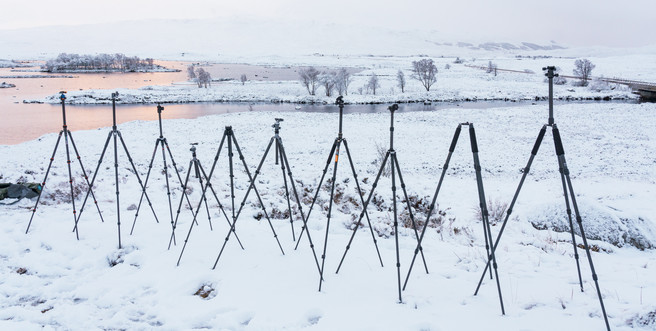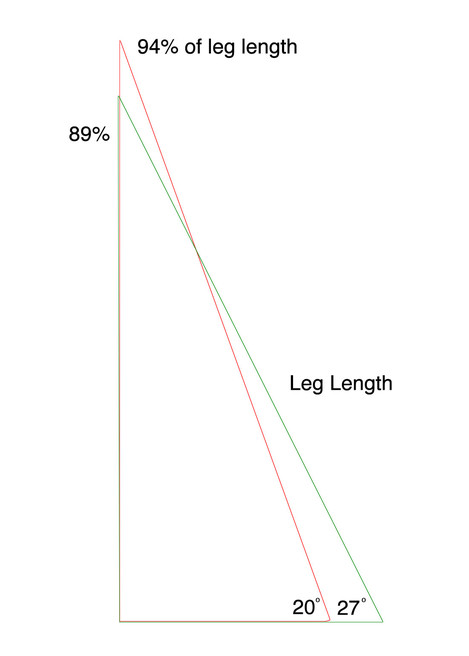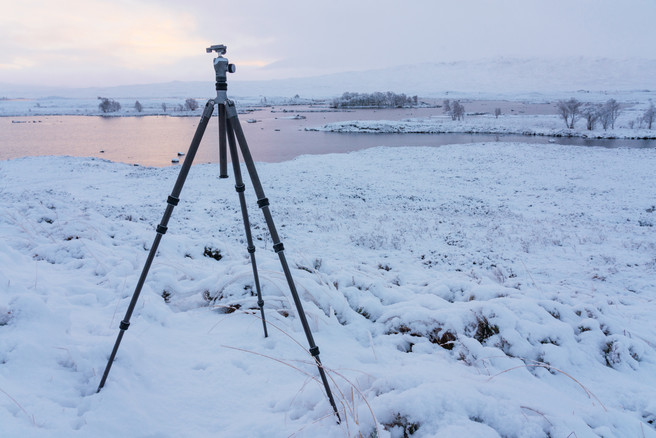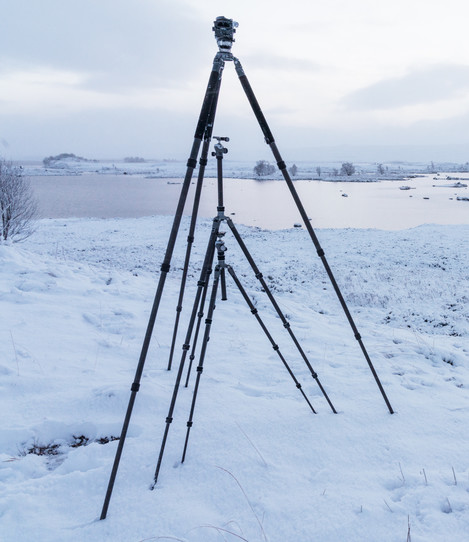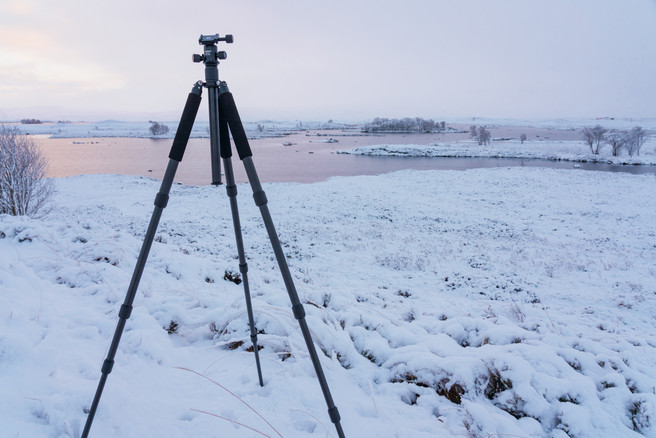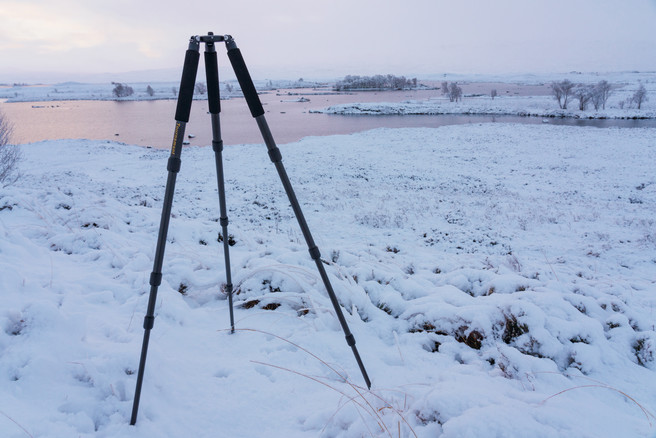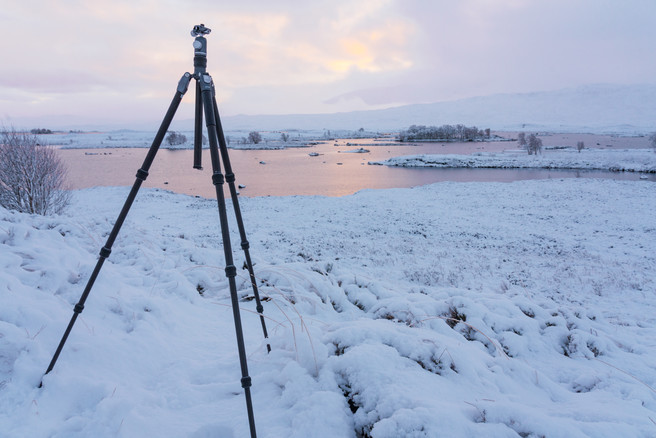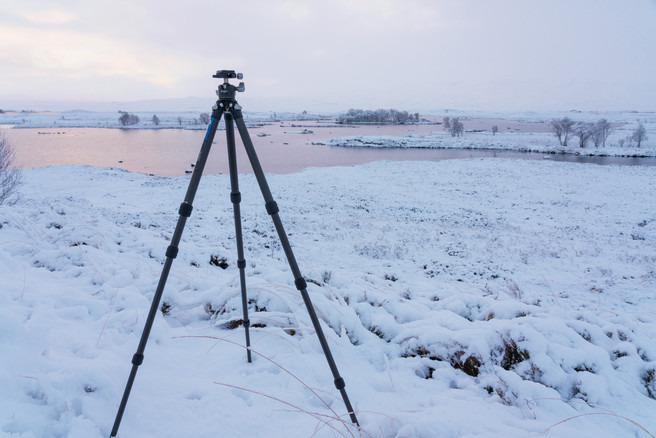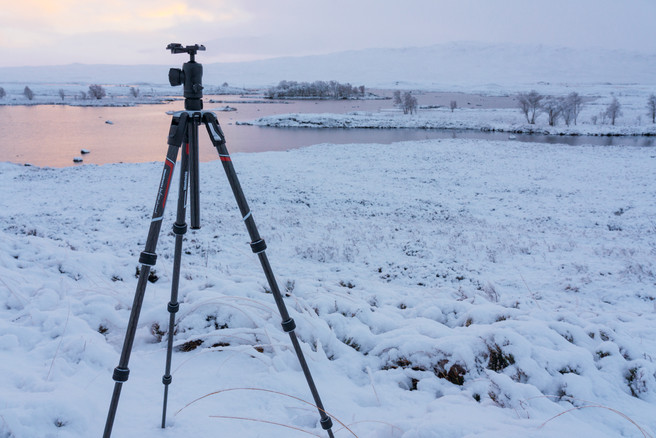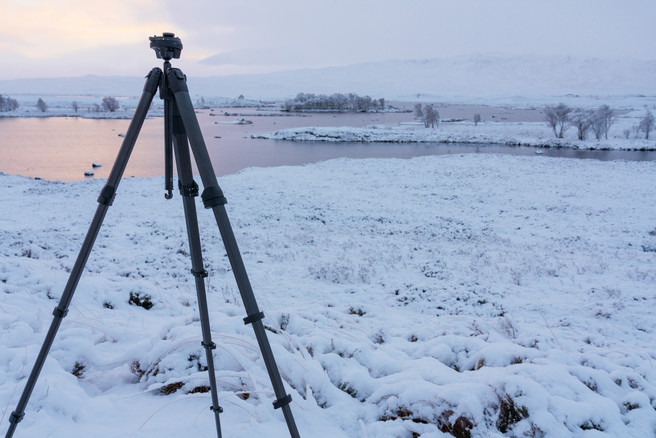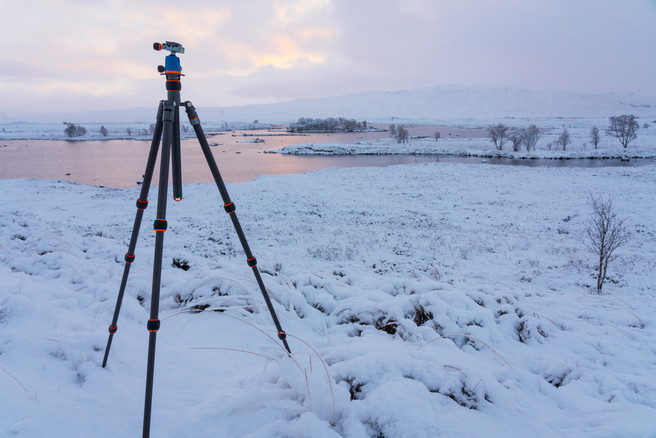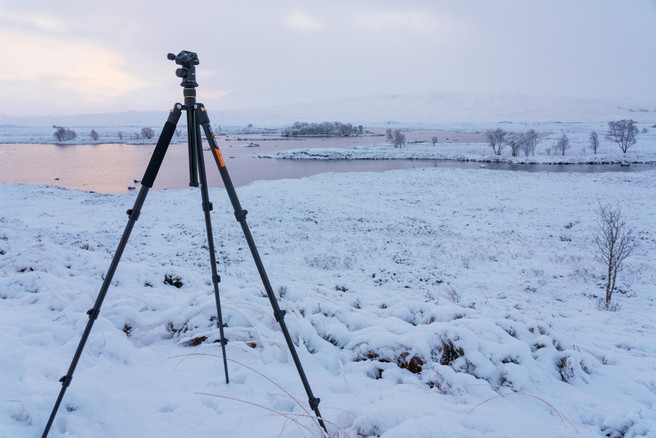Lightweight Legs for Landscapers

Tim Parkin
Amateur Photographer who plays with big cameras and film when in between digital photographs.
Over the last few weeks, I’ve been testing out a range of travel tripods. As with most of the testing we’ve done, it all starts with a personal question and ends up with me getting carried away.
In this case, the personal ‘question’ came about because I wanted to go camping in the mountains and combine it with landscape photography. Typically the idea of lightweight camping is to get down to the minimum possible weight and still function safely and comfortably (ish). I’ve already made a bunch of these decisions for camping gear by looking at the many lightweight camping websites out there.
However, a major portion of the weight for a photographer going lightweight camping isn’t in the camping gear (generally) but instead it is the photography gear. The decisions on which system to use are often quite subjective ones as well - I can’t justify investing in an extra Micro Four Thirds system and I love the quality from my Sony A7R3 (or Chamonix 4x5 camera) and sticking with a single zoom lens works well for me. My gear questions arose because the only two tripods I own are a very heavyweight Gitzo 3541XLS with an Arca Cube and a levelling base and a very old Velbon Sherpa CF with an Acratech Ultimate ball head. The first is nearly 4kg in weight and the latter is still 1.6kg and a bit bulky (and old, and not compatible with spiked feet - more on spikes later).
So I started looking at travel tripods and wanted to know whether these very lightweight tripods are really worth the compromise and out of a small selection, which performs the best.
Criteria for Inclusion
First of all, I needed to work out my base criteria for inclusion in the test. Being as the Gitzo 1545t is pretty much the reference travel tripod for most people and it clocks in at a decent 1kg weight, substantially less than my current tripods, and is an almost comfortable 1.3m height, which is just tall enough for me to be able to use the viewfinder without bending over, I figured selecting tripods near this specification made sense.
The following tripods were the primary selection...
- Gitzo 1545t
- Manfrotto Befree Advanced Carbon
- Three Legged Thing
- Feisol CT-3441T
We also did a bunch of searching to try to find other tripods that might fit the bill. One tripod that was recommended by a few people was the Benro. Their marketing team recommend a new release, the Benro Rhino FRHN14CVX20. Another tripod manufacturer that was recommended was Leofoto, a brand I had not heard of before. They recommended the Leofoto LS-284C.
We asked for review loans for the Gitzo, Manfrotto and Feisol but as our deadline for starting testing approached we had not been able to source them (a block on marketing because of Covid or no response at all). So we ended up buying the Gitzo and Feisol. With typically annoying timing, we received a couple of phone calls on the day the two tripods arrived asking us if we’d still like to loan the Gitzo, Manfrotto and Feisol tripods. We decided it was worth asking for different versions of each to expand on our selections so we asked for a 0 series Gitzo and the Feisol without a centre column.
On top of these, K&F Concept somehow heard about our tests and sent us a sample of their tripod line. It wasn't carbon fibre but it matched the specifications so we included it as a sample of the base budget choice.
Finally, we really wanted to test the Really Right Stuff travel option and the Peak Design tripods but we received no response from either company. Fortunately, a good friend was willing to loan me his Peak Design tripod for these tests (Thank you David Knight. Sorry it took so long!). Nobody I knew had the RRS travel option so we’ll have to imagine that they were outside of our budget!
So the final list was
- Gitzo 0545t
- Gitzo 1545t
- Leofoto LS-254C
- Manfrotto Befree Advanced Carbon
- Benro Rhino FRHN14C
- Three Legged Thing Billy
- Feisol CT-3441T
- Feisol CT-3442T
- K&F Concept TM2324
- Peak Design
What Makes a Good Tripod
My first thoughts when I was looking at testing these tripods was to go into different aspects of leg stiffness, torsional rigidity etc i.e. completely geek out. Amazingly though, someone else has already gone the full geek and tested most of the tripods we’ve included. The Centre Column website has done an excellent job of looking at quite a few different aspects of tripod design and we’ll summarise a few of them as part of this test. Their main technical criteria was system stiffness and as much as this is one of the key features of a tripod, after all what use is a wobbly platform for your camera, I wondered if there wasn’t a stiffness point beyond which the system was “good enough” and when other aspects of the tripod became key differentiating factors.
So other than stiffness, what else can we assess? Let’s make a list.
- Price
- Weight
- Stiffness (all parts)
- Packability
- Usability
- Leg locking system
- Leg sliding system
- How easy the use and stow cycle is
- Field Adjustment
- Center column
- Spikes/Feet
- Ballhead mounting system
- Ease of cleaning
- Water tolerance (and salt water)
- Stability, centre of mass, leg angle
- Leg Joints
- Spare part availability
Phew! That's quite the list! We can leave price and weight for the full summary so let’s start with stiffness.
Stiffness
The stiffness of the whole system - legs, leg joints, leg hinges, spider, ballhead mount - all adds up to create a tripod that doesn’t move when an external force is applied. It is totally true that any tripod can make sharp images if we have no external force (e.g. wind) or internal force if we have a big flappy mirror and shutter. It is also true that you cannot make sharp pictures if the forces applied to the system are too large, regardless of the tripod uses (an Icelandic storm perhaps). So what we’re after is a tripod that is just good enough for the majority of situations we might encounter. It’s all a trade-off with the variables being lightness, height and budget. Move one of these variables affects the other two.
Packability
This doesn’t just mean the collapsed length. It also includes the diameter of the collapsed system and whether it can attach to the side of a camera bag well. For instance, the Leofoto tripod has a very small ‘spider’ (the bit that connects the legs and that the head mounts on) and no centre column so the diameter of the collapsed system is very small whereas the Feisol 3442T has a giant spider to give better stability but because of this the system tapers and makes attaching to a camera bag harder.
Usability
There is no point having a supremely lightweight, stiff and cheap tripod if it’s an absolute pain to use. There’s nothing more frustrating than fighting with a tripod as the light disappears in front of you. Or adjusting a leg to recompose and then finding the whole system slipping as you look through the viewfinder. Finally, I have found that the process of stowing the tripod can sometimes be a pain i.e. having to raise the centre column, collapse the legs and then having to fiddle with the ballhead in order to get the legs to sit flat can be quite irritating. Obviously you can leave a tripod with this system uninverted whilst wandering around so it isn't a major issue.
Small things can make a big difference though and landscape photography at its best lets you enter a wonderful ‘flow state’ and anything that breaks that spell is a big negative in my opinion.
Leg Locking
The way that the legs lock on a tripod is critical. There are two physical systems, either flip locks or twist locks, and within the twist lock category, there are two variations - firstly a simple progressive tightening, wind it more and it gets tighter gradually, and secondly a ‘click’ stop where you reach a certain point and you get a final positive lock (the Gitzo is the reference here). There’s been a lot of discussion about which is better, levers or twist locks but the consensus seems to be that personal preference is the most important factor.
It seems that the differences between the Gitzo style twist lock and the normal ‘progressive’ style lock is also down to preference although I much prefer to have some physical feedback as to when the locks are tight enough. i.e. I think there are two advantages to the Gitzo style ‘positive lock’. The first is that you don’t need to turn it very far between locked and loose and secondly, the click does give you confidence that you’ve achieved full lock. Only the Leofoto has a similar positive lock like the Gitzo and the Leofoto has the smallest turn needed to go from fully locked to fully unlocked.
Leg Sliding System
Once you’ve got the legs unlocked, how easy is it to slide them in and out? In the best systems, the legs will be almost completely loose in a small turn (or flip) of the lock. In the worst system, the legs will be randomly stiff, even when fully unlocked. The Benro and Three legged thing tripod suffered from this random stiffness. On both tripods you had to turn the leg locks more on the sticky legs to get a smooth release.
Deploying and Stowing
If we look at the usability of deploying the tripod into a medium height stance and then closing and stowing the tripod onto your camera bag there are a few factors that can make a difference. The relatively new system of inverting the tripod legs around the centre column makes for a smaller package but it can be a pain to get the ballhead in the right position to close the legs up as tight as possible (the clamp and tension knobs can block the legs from closing completely). This also limits you to using slimline ballheads which have their own disadvantages.
Field Adjustment
Beyond setting up and stowing the tripod, the main usability issue can all be summarised by "field adjustment". How easy is it to make small to medium adjustments of tripod height and leg angle. Can you make the adjustments with gloves on? Can you be confident that a leg is locked with a quick twist? How easy is it to pull out the leg angle adjusters? Fortunately, all the tripods tested were usable with gloves on and the only real usability annoyances were having to turn the leg locks more on some tripods than others.
Whilst I'm talking about field adjustment, a colleague had a little rant at me about the lack of bubble levels on some tripods. For something hard to add after the fact, it would be great to see more tripods with bubbles built in.
Centre Column
The centre column is a necessary evil for travel tripods. In order to get the weight down, nearly every manufacturer opts to use a single centre column to increase height rather than adding length to every leg. Using the centre column degrades image quality more than having equivalent extra height bu extending the legs. This is because flex in the tripod tends to cause a rotating movement around the camera mount point. If the camera mount point is extended away from the vertex of the tripod though, this rotation is converted into lateral movement (see diagram below).
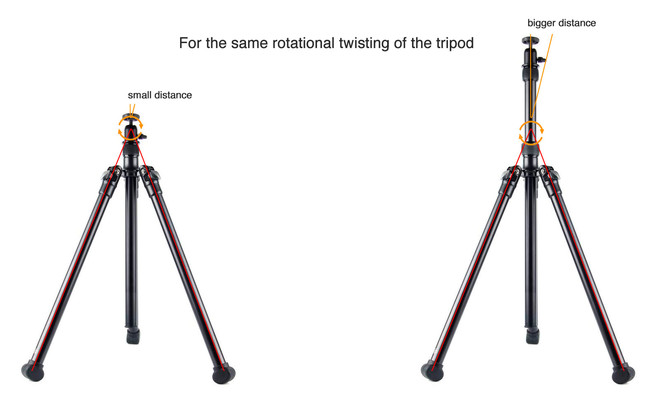
Centre Column Weight Hook
Most higher-end tripods include a hook on the centre column or base of the spider in order to weight down the tripod to stop it from tipping and also to increase its stiffness. The only tripods in our test to exclude this capability were the Manfrotto, which just had a rubber stopper pushed into the carbon fibre tube, and the Gitzo 0 series for which I could find no centre column hook.
Spikes/Feet
The use of longer spikes on tripods has gone from a rare option, only available on some of the larger and more expensive tripods, to being pretty much compulsory at all levels. There are few tripods that don’t have the option of changing the tripod feet in this test it was only the Manfrotto and K&F tripods.
Ballhead Mounting System
There’s not a great deal of importance in this but there are a few things that companies can get right or wrong. Most tripods in the test were adequate and only the Manfrotto and K&F didn't use a metal base.
Spider Size
The bit of metal that connects the legs to the ballhead is called the spider and there are a few different options for this. It can be large or small and there are advantages of both. A larger spider brings the apex point of the legs higher (see below) but it becomes a disadvantage in packing the tripod to a small volume. Likewise a small spider will allow packing down nicely but the apex of the legs will probably be below the camera. The two extremes here are the Feisol 3442L and Leofoto LS-284C as shown below.
Materials Used
The gold standard for the material a spider is made from is undoubtedly machined magnesium or even aluminium alloy. The old Gitzo tripod heads are cast and have had problems being brittle in some situations and with age. Some spiders have a plastic base that the ball head screws down onto which does affect stiffness in a very small way (imperceptible for hard plastics) but could be an advantage in that too much stiffness can cause vibration to persist and a plastic piece could help damp vibrations.
Ballhead Bolt attachment
Not much to cover here but it’s a real advantage if you can access the other side of the tripod spider to be able to unscrew a tripod head that has become stuck. I’ve had a few times when I’ve had to fight with tightening a panning base in order to put enough force through the tripod head to remove it. Obviously, with a centre column in place, this is more difficult. Perhaps tripod heads should come with a panning base locking screw to get around the issue.
Ease of Cleaning
We all know we should clean our tripods occasionally and we should definitely do so after exposure to salt water. Many people don’t like doing so because of the fear of being able to put everything back together again afterwards. The Gitzo tripods have to white plastic bushings that are notorious for flying off and a pain to try to align to get back on. They’ve since updated the bushings to help with this. We've had feedback from tripod returns that not dismantling your tripod after using in saltwater can leave areas of the carbon fibre tube in contact with concentrated salt water for a long time. Water will only evaporate normally when it is exposed to the open air. Trapped inside the legs of a tripod and it will stay damp for days if not longer. Constant exposure to this salt water can cause parts of the carbon fibre weave to expand and ruin a tripod. This is a feature of all carbon fibres, even ones supposedly design for salt water use. Hence, if a tripod can be dismantled and cleaned easily then it’s a definitely bonus.
Water Ingress/Rejection
We've mentioned the importance of cleaning your tripods when they’ve been near salt water and, if you're extra vigilant, cleaning the legs when they’ve been immersed in fine silt so prevent the leg locks from prematurely ageing. However, the tripod design can help reject water and particles. Gitzo even created a tripod specifically for salt water exposure which had stainless steel parts and extra seals in the leg sections. The crystals of salt that form when seawater evaporates can cause quite serious wear in the plastic components of the leg locking systems. The Gitzo tripods have introduced an 'O' ring into the leg locks which should help reduce ingress of water. Fully sealing the legs of a tripod, whilst sounding like a good idea, would create a piston effect and make it difficult to extend and collapse the legs.
Stability and Leg Angle
Tripod legs usually have two or three ‘stops’ that allow them to be fixed at set angles. These are adjusted by manipulating a tab at the top of each leg. The angles used for the two wider settings aren’t that important but the angle that makes the tripod as tall as it will go is a trade-off for manufacturers vs users. If the angle of the leg at maximum height is quite small, this will make the tripod taller but at the same time more liable to tip. A wider stance, created by making the angle bigger, makes the whole tripod more stable.
For instance, the Feisol has a leg angle of about 20 degrees which is perhaps a little too ‘tippy’, whereas RRS tripods use 27 degrees which isn’t a big difference but it does sacrifice height (a possible 4% reduction in peak height by using a sensible 27 degree angle instead of a ‘tippy’ 20 degree angle - or nearly 5cm on one of our travel tripods).
The difference isn’t huge, 21 vs 27 degrees, but it could make a 30-40% difference in stiffness. You can always just widen your tripod legs if it’s a worry or even file a bit off each leg stop for a more permanent solution. Something to be aware of though.
Only the Manfrotto, Leofoto and Feisol used angles around 21 degrees.
Leg Joints
The leg joints are a minor point. As long as they don’t flop around or get too ‘sticky’, they should be fine. The ability to adjust tension is important though as they can change in tension through wear or temperature etc. Most of the tripods allowed easy tensioning.
Spare Parts
It’s definitely better to pay more for a tripod and have access to reasonably priced spare parts than having to replace a whole tripod if you break or wear something out. I can still get spare parts for my Gitzo 3540XLS twelve years after I bought it. This is a good reason to get a reasonably new model as the spares will be available longer. We've asked for feedback from manufacturers for spare parts and will get back to you about this.
Individual Tripod Impressions
The following describes each tripod in the test with some of its advantages and disadvantages. You can view the measured data about each tripod by following this link to a Google spreadsheet. Feel free to make a copy or download it if you want to play with the sorting etc.
Gitzo Traveller 1545T
The Gitzo 1545T must be the standard to which other tripods are assessed. Since RRS have come to market, they may not be the best tripods anymore (but the RRS equivalent is well over twice the price!) but people know them well and know the quality you’ll get. And this quality shines when you’re handling the tripod. The locks are positive and smooth, legs travel freely, angle stops are nice to use, the finish is exemplary etc. etc. The only thing that really let it down as far as first impressions go is the crappy dust bag instead of a proper case.
The tripod folds down well although lining up the ball head protrusions properly to get a compact package is a bit of a pain, something you get used to probably.
The Gitzo leg locks are excellent and provide a short throw between fully locked and fully loose with a positive end stop. This means you rarely have to go back to a leg lock to open further or lock it down a bit more.
The centre column is implemented well, although it does lift the ball head up above the apex of the legs and hence transmits more movement to the camera.
It’s a bit disappointing that Gitzo chose to use a different thread for the feet on the smaller series tripods. These are a ¼”-20 instead of the normal ⅜” thread and so you need special spikes for them. The Three Legged Thing spikes fit nicely though.
The ballhead mounting plate is solid and although you can’t undo the head from underneath because it has a centre column, it does have a removable plate which may help give traction should a head get stuck.
The legs are easy to remove for cleaning and you can see the o-rings that Gitzo now include that will help prevent ingress of water. The old two part white bushings have gone and the new bushings are a single piece that is a lot easier to put back on reassembly. The leg hinges also appear easier to tighten than older Gitzo tripods (where the star allen key used to just strip as it cammed out too easily).
Gitzo Traveller 0545T
Not much to say about the 0545T as it really is just a baby version of the 1545T. The bottom leg section is quite tiny but is a thicker carbon fibre tube and hence is stronger. It should be noted just how small these tripods are compared with an extra tall tripod. Here's a comparison with my Gitzo 3540XLS and the two travel Gitzos.
Feisol 3441T
The Feisol tripods are a bit of an enigma, they’re not promoted well in the UK and I don’t think they have an agent at all now. They’re based in Germany and although I don’t know many people who use them, those that do are very pleased with them.
First impressions of the Feisol are generally a little disappointing. They’re lacking many of the fancy design features of the higher end tripods but you shouldn’t be deceived. When you start to use them you notice that attention has been paid to usability instead of fancy details. The legs lock smoothly, although not as positively as the Gitzo and the legs open and close with almost zero resistance. The spider is made of machined aluminium, as are the leg locks. The hinges are smooth but stiff and although the legs come with difficult to remove rubber ‘hats’, once pushed off (imagine popping a cork rather than twisting off) they have a decent threaded insert for spikes.
The centre column is as smooth in use as the legs are and at full reach, it’s the tallest tripod here and although it ends up the heaviest tripod in our tests, it’s only just heavier than the Benro. If you replace the centre column with a short column, you get Peak Design weight but it’s still at the heavy end. This weight is put to good use though as the tube dimensions of the legs and centre column are bigger than any other tripod listed.
Feisol 3442T
The 3442T is pretty much the same as the 3441T but with a bigger spider and no centre column. This enlarged spider does two important things. It not only adds significantly to the rigidity of the system but it also puts the place when the legs converge up toward where the camera is, which means if the tripod does twist, the movement of the camera is minimised.
Overall, both Feisols seem to be really basic but solid tripods.
Benro Rhino FRHN14C
Benro have been steadily releasing innovative products for the last few years. These have been a bit hit and miss, but fortunately for us, a lot more hit than miss. The Benro tripods have already created quite a few fans and the new Rhino range is, I’m sure, set to get some more. The Rhino represents the premium end of Benro’s tripods (a Tortoise range is set to come that skips the centre column - we’ve only just found out about these so more info later). As such they should be more of a match for the gold standard Gitzo’s.
First impressions are very good. The materials look high quality, almost to Gitzo standards, and the design is all clean lines if a little ‘flouncy’ (I prefer to have something a little more functional looking but that’s subjective). On using the tripod for the first few times I was disappointed in how much I had to open the twist locks in order to have the legs slide smoothly. Some of the legs were fine but a couple of them were ‘sticky’ and one was really bad. I found out that the plastic sleeve inside that leg had become folded and when I fixed it it was OK but still not smooth. In use, this improved but I still had to turn the twist lock more than I did on the Gitzo.
In use, if we ignore the slightly sticky legs, the tripod works very well. I like the use of a decent size hook at the bottom of the centre column but, from what I can see, the centre column can’t be removed and replaced with a short column.
Leofoto LS-254C
The Leofoto was a bit of a surprise. They’re not a manufacturer I had heard of before researching this test and so I didn’t know what to expect. What I actually got was a real treat though. At the price, I was thinking it would be a run of the mill Chinese white label but in actual fact, I received a really sturdy and well made compact tripod with a few innovative features.
Firstly, this thing is compact! The spider at the top is very small and yet still has enough space to mount a decent compact ballhead. Essentially the tripod legs run parallel to each other when closed. The big difference with this tripod to many of the others is that it doesn’t have an integrated centre column. Instead, it has an accessory column extension. This expanding column just screws into the main tripod instead of the tripod head and then you attach the tripod head on the top. Being as we only use the centre column occasionally, this appears to be a good compromise which allows the tripod to be more compact (and lighter in case you decide to leave the centre column at home). Not everyone will get on with this but I’m a fan!
The tripod appears to be very stiff and the legs have a very short and positive twist lock, the shortest in our test selection. Overall a very pleasant surprise with a clean and modern design. Leofoto may have a reputation as a rip off company (yes they have borrowed quite a lot from Gitzo, Arca Swiss and others) but they also add in some of their own innovations.
Manfrotto Befree Advanced Carbon
This particular Manfrotto is their choice for the advanced photographer and represents their top of the line travel tripod. Out of the box I have to admit to being a little underwhelmed. First impressions count and this tripod gave off plasticy vibes. In use, it was actually better than expected. The twist locks were OK but not great. The feet were just ribber inserts and so there would be no option for spikes or something more solid. The centre column was a bit sticky and took some undoing with, again, just a rubber plug in the end.
Overall, I was left feeling a little underwhelmed.
Peak Design Carbon Fibre Travel Tripod
When I heard that Peak Design, the company behind a few Kickstarter bags and camera straps, were making a tripod, I was initially sceptical; very sceptical. When they delivered, the product was so different from existing designs that I figured there must be a downside - innovation for innovation’s sake. However, when I received a package from my old school friend, I was quite surprised. Not only does it ooze quality, it actually felt like it might be a proper, functional tripod!
So, after taking it out a few times into the field my final assessment is that not only have Peak Design created something innovative but also that ticks most of the boxes for an excellent travel tripod.
So what are all of these innovations? Well, firstly the tripod legs aren’t cylindrical. They’re shaped more like a segment from an orange. This makes sense once you collapse the tripod legs as they make the most of the space available. The legs are in 5 sections and use lever locks (a little thought will explain why they don’t use twist locks). These locks are very secure and surprisingly usable, even with thick gloves on. The bottom legs section is very small and I was a little doubtful whether it would be stiff enough but it seems OK so far after a few days in the field.
Next, the tripod head is of the ‘inverted’ style where the ball is attached to a slim but stiff centre column and the head wraps around it. This allows the head to collapse down flush with the top of the legs.
The tripod head itself is part of the tripod and although is replaceable with a universal head adapter, you lose most of the advantages of the system so we were hoping it was good enough. Thankfully it is decent if not amazing. The clamp system wraps around the perimeter of the ‘base’ and works with Arca Swiss style plates (and the Peak Design plates obviously). The head lock control also works around the perimeter and locks the head adequately.
There are also a few hidden extras, such as the allen key device attached to one leg and the phone mount hidden inside the centre column.
All in all, a very competent tripod. If a little expensive.
Three Legged Thing
The brand that took the budget tripod industry by storm. Three Legged Thing are the brash and boistrous younger brother to the mature Gitzo’s and RRS’s of the world.
I hadn’t seen many of these tripods in the flesh but anecdotally I had more negative opinions than positive ones. “Make your own mind up”, I reminded myself. As it turns out, my photographer colleagues had it right in this case. The tripod looks snazzy enough in its metallic orange trim and subway graffiti logos but like the local lads with their ricer cars [https://www.quora.com/What-is-a-ricer-car], the performance doesn’t live up to the flashing undercarriage.
The locks aren’t that positive, the construction is pretty basic but sort of functional. Think Trabant not Tesla. That said - when the legs are locked down, the fact that the carbon fibre tubes it is made form are pretty burly means that it’s fairly stiff. It certainly seems stiffer than the Manfrotto but I hope to test this in a follow up to the article.
I remind myself that this is the budget brand and not to expect too much. But then I check and find out that the Benro is only £5 more expensive than the 3LT’s £210. If you want real budget you have to look at the …
K&F Concept TM2324
Proper budget! This isn’t carbon fibre. It has no bells and whistles apart from a bit of gold effect on the leg angle stops. We weren’t even going to include it in the test but the company got in touch with us and asked if they could send a tripod. I presumed it would be too heavy, or not tall enough or flimsy. In fact, it wasn’t the heaviest or the shortest and it certainly wasn’t the flimsiest. I reckon you could use this tripod quite happily in more benign conditions and as such sets a pretty good baseline for what a budget tripod should look like (£45 with the code KF10US). Not an embarrassing show at all!
Conclusions
Well, after testing these tripods over the last couple of months, what are my final opinions. Originally, I was thinking about making a lot of scientific tests of stiffness and torsion resistance and resonance and.. and.. and then I started using the tripods and realised that these aspects were mostly self-evident from the feel of the tripods and when they weren’t obvious, usability aspects played such a big role that for broadly similar stiffness, I’d choose a more usable tripod and one that matches my particular need over the one that was the stiffest.
Don't forget to check out the spreadsheet of specifications and measurements. We've created a shared Google Spreadsheet which you can access by clicking here
Gold Standard : Gitzo 1545T and 0545T
So, which of these tripods really stood out? Firstly I have to say that you can’t go wrong with a Gitzo. The relative price of Gitzo’s seems to have come down a bit recently and the price of mid range tripods has gone up, making the Gitzo choice less painful.
Compact: Peak Design Carbon Fibre Travel Tripod
Alongside the Gitzo, I was really impressed with the Peak Design Carbon Fibre Travel Tripod. It’s a hell of a lot stiffer than I expected and the only real downsides are a little bit of usability. The head is adequate and not being able to upgrade or choose a different head is annoying. However, as a true travel tripod (i.e. one to take on a proper holiday) it really does take some beating. It packs down beautifully and does everything you ask out of a tripod and is stiff enough to handle some inclement conditions.
Lightweight: Leofoto LS-254C
The tripod that really stood out to me, so much so that I bought one for myself, was the Leofoto LS-254C. I love the fact that it doesn’t have a centre column and yet has an accessory column if I really need the height. I really love the low weight and compact design that straps to the outside of a pack really well (and is small enough to go on the inside too!). Combined with a stiffness up there with the Gitzo and Peak design it’s a cracking option for a landscape photographer looking for the lightest reasonable solution.
Robust and Tall: Feisol 3441T and 3442T
The Feisol tripods ticked the stiffness boxes as well but are more suited to someone who needs a bit of extra reach as the centre column version, the 3441T, is the tallest in our test. Alternatively, the 3442T with its very large spider gives a reassuringly solid base, albeit with the downside of being quite bulky. If the packability isn’t an issue, then these are very functional solutions.
Budget All Rounder: Benro Rhino FRHN14C
The Benro was just not quite up there with these other options. It was neither the smallest, lightest, lowest volume but it was the cheapest that still gave a reassuringly solid feel and there is no doubt that as a package you get a lot of bang for your buck.
The Dissapointments
The two tripods that really disappointed me were the Manfrotto and the Three Legged Thing. The Manfrotto was a little surprising as coming from the same company as Gitzo you’d expect something capable but just with a budget feel. But I suppose they don’t want to cannibalise their Gitzo customers.
Proper Budget: K&F Concept TM2324
Finally, the K&F Concept was a real surprise. For what I thought was going to be a heavyweight pile of junk, it was actually a pretty decent first tripod for the real budget-minded (you can get this for a 10th of the price of the Gitzo and the Peak Design and, if you look hard, 20th the price of an RRS). They say with tripods, buy cheap, buy twice but in this case you really aren’t losing much by trying this out.
Coming Up
Thanks for bearing with me in what turned out to be a fairly epic look at the set of travel tripods we had for review. It should be no surprise that there isn't one 'winner' here, nearly all tripods trade off statistics against each other, height, weight, price, stiffness, etc. All the tripods tested will function adequately in the benign conditions that most photographers work in. However, if you're going to end up in Iceland battling a roaring storm wind, very few tripods will do the trick, the heavier the better though. I think most photographers have at least considered owning two or more tripods, a big heavy 'car' one and a lightweight 'I'm walking to Blea Tarn' one. I know I've ended up with three tripods* since this review and Charlotte might give me Paddington Bears if I consider another. (*Leofoto LS-254C for the small one, Gitzo 3541XLS for the large one and a Buddiesman for in between - more about that in a future issue)
I was going to end the article here but I couldn’t stop myself geeking out a little bit. I’m going to go and hide in the shed over Christmas and do a bit of MacGyver testing on the stiffness and wind resistance of these tripods. I don’t expect my conclusions to change too much but I’m going to have some fun with levers, cogs, beepy things and shiny lasers so who cares.


